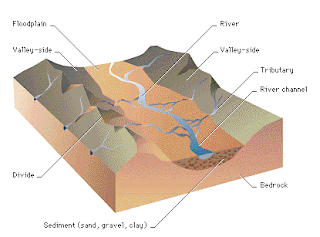Hard rocks are hard to erode, soft ones erode much easier. Where hard and soft rocks were side by side we often find the soft ones have been eroded out leaving the harder rocks as an upland feature.You will need to use this idea to explain the development of a landform.
What the Syllabus Says - and the Details
Valleys
River erosion in upland areas often forms ‘V’-shaped valleys. For an explanation of how this happens click here .
‘U’-shaped valleys will have been made by a glacier that has now melted away.
Valleys in lowland areas usually have wide flat floodplains.
Valleys may reflect the underlying geological structure if the river has eroded out its valley by following a weaker rock.
Valleys can appear to ignore the geology. This is called discordant drainage. It happens when the river is actually following a line of weakness made by something else (such as a glacier or fault line).
This map shows the River Severn (white line) following the Ironbridge Fault through Shropshire, cutting across all sorts of rock types as it does so.
The map below shows a discordant river following an U shaped valley. Note the flat bottom of the valley (no contours) and very steep sides (lots of contours). The river follows the bottom of the valley, which is clearly too deep for the river to have made. Compare it to the U-shaped valley in the picture above.
You need to be able to describe valley cross profiles from maps, photographs and field observations and to be able to work out the process responsible for valley shape.
Other Landscape Features
The variation in resistance to weathering and erosion of different rock types and structures results in a variety of landforms:
• Plateau – a feature made by hard horizontal beds that have not been eroded through - the cross section below shows two plateaus, one on top of bed 1 and one on top of the speckled grey bed (top right). Notice the brilliant unconformity at the bottom of bed 6 as well!
• Scarp and vale – made from gently dipping beds. A hard, gently dipping bed (e) makes the back of the escarpment (c); where this has been eroded through and the softer rocks (f) under it have then also been eroded out a steep face, called the scarp face (b) is left. At the bottom of the scarp face is the flat are of land on top of the easily eroded rock type - the vale (a).
• Ridge – these are made where a hard steeply dipping bed or a dyke stands up but the surrounding softer rocks have been eroded away.
• Upland area – these are made where a pluton still remains due to its hardness, but the surrounding softer rocks have been eroded away. These upland areas tend to be large due to the large size of the plutons. The map below shows the geology that makes Dartmoor...
and the photograph below shows the scenery typical of this type of landscape.
• Fault scarp - these are steep slopes formed due to the slipping of a normal fault. For further details on this, and much more about faults, click here .
• Coastal landforms [high cliffs, headlands and bays]
This material is covered in really well at this site .
You need to be able to interpret the relationship between geology and landforms using maps, photographs and field observations










Really Good. Thanks!! I ERM... LOVE IT
ReplyDeleteDavis Pye = Legend
ReplyDeleteI passed my GCSE because of you xx
I meant David
DeleteI deeply apologise for any inconvenience caused. Please accept my signed photo of myself which is being sent to you First Class as we speak.
Yours Truly,
Samantha
This comment has been removed by the author.
DeleteDearest Dave
DeleteI hope you enjoy the glitter bomb included.
Hope to hear from you soon.
Love to all your Family
Samantha Chefdaughter
Dear ' so called David Pye'
ReplyDeleteYou are not David Pye. You Are Thomas and you are far from cool. Get a Life. My Friend Dave has had his glitter extravaganza destroyed
Samantha
Sam - delighted that the blog site worked for you - and that you passed the GCSE - congrats. Your sense of (impatient) humour seems to work faster than my email replies but hey - thanks for taking the time to say thanks.
Delete